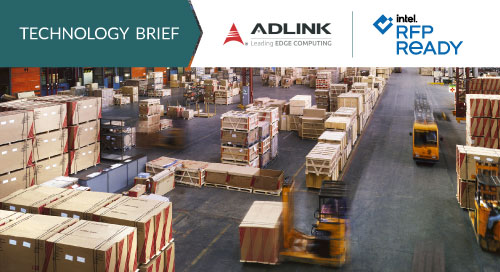Fill form to unlock content
Error - something went wrong!
Get the latest on IoT and network edge for manufacturing.
You are following this topic.
Improve Warehouse Operations with Machine Vision and Edge AI

As more industries realize the value of connected machines and devices, IoT adoption is growing by leaps and bounds. By 2025, there will be more than 25 billion IoT devices in industries ranging from electricity and gas to retailing, wholesaling, and transportation.
Machine vision enables machines to identify objects and analyze scenes and activities in real-life environments. When paired with AI, machine vision can simulate the human capability of solving complex problems. This Industry 4.0 approach drives industries from automation (where humans program machine decisions) to autonomy (where the machine makes decisions based on real-time data).
One company that excels in providing its customers this advanced capability is ADLINK, a global company that uses embedded computing technology to deliver the Analog-Digital LINK (hence the name) required to accelerate deployment of artificial intelligence at the network edge.
A More Powerful Edge AI Solution
The IoT gives businesses real-time information they can use to solve problems quickly and operate more efficiently. But traditional IoT technology has some significant limitations. Because it uses wide-area networking to transmit data to the cloud for processing before returning results to the decision-maker, it does not deliver the real-time decision support needed for warehouse robotics. It also requires huge bandwidth resources.
These shortcomings have given rise to new approaches that combine machine vision technologies with artificial intelligence.
“Edge computing is about applying the right data, at the right time, in the right place, to drive the right decision and take the right action. Accomplishing that outcome demands the employment of artificial intelligence at the edge,” says Daniel Collins, ADLINK Senior Director of Edge Solutions.
The Smart Pallet solution couples #MachineVision and #ArtificialIntelligence to provide fully automated visibility of all #warehouse packages and pallets. @Adlink_IoT via @insightdottech
Smarter Warehouse Solutions with Machine Vision and Edge AI
An excellent example of effectively deploying computer vision at the edge is the ADLINK Edge Smart Pallet solution. This product is an ecosystem of warehouse technology, including applications, sensors, analytics engines, and operational systems.
Connected through the ADLINK Data River, these components combine to deliver autonomous Industry 4.0 solutions to address multiple customer pain points at the edge, such as:
- Packages that contain the wrong merchandise or are lost, stolen, or delivered to the wrong place.
- Lack of inventory visibility during packaging, palletization, and distribution.
- Siloed and unconnected systems that make automation and process monitoring impossibly complex, intrusive, and expensive.
- Bandwidth and latency challenges posed by transmitting data to and from the cloud.
- Privacy concerns associated with some 5G WAN solutions.
The Smart Pallet solution couples machine vision and edge AI technology to provide fully automated visibility of all warehouse packages and pallets. This methodology replaces traditional barcode hand-scanning with machine learning, helping to automate all aspects of the manufacturing process from pallet stacking and box finding across warehouse facilities. It also eliminates inventory errors caused by misplaced and non-scanned items (Video 1).
By capturing multiple image data streams and applying high-performance computational power, machine learning at the edge can increase warehouse automation while simultaneously improving efficiency and accuracy.
Edge computing systems also eliminate the need to transmit data to the cloud, using a high-bandwidth local area network to collect and process data locally. Smart Pallet connects to new and existing equipment, using a vendor-agnostic approach built on open standards. The entire platform is architected with modular components to ease integration with existing IT and OT systems.
Creating the Machine Vision Solution
One of the biggest technical challenges ADLINK had in developing the solution was collecting enough data to train the artificial intelligence models. It solved that problem by using Intel® technology in the computer vision cameras.
The solution’s standard package consists of an ADLINK NEON-1000-MDX, industrial-grade smart camera with onboard storage and compute. That component uses an Intel Atom® processor, an Intel® Movidius™ Myriad™ video accelerator, and the Intel® OpenVINO™ Toolkit machine vision framework—which comes with pre-trained AI models. Using this framework as a starting point, ADLINK created its own AI models to locate individual packages and provide a visual display of the pallet on a computer monitor.
As a longtime Intel partner, ADLINK also relies on Intel’s supply chain security. This aspect is of critical importance to customers who are required to meet legal and regulatory certifications.
Machine Vision Systems Help Boost Efficiency and Stop Theft
Automatically reading barcodes saves enormous amounts of time for warehousing and manufacturing operations. After adopting ADLINK, a global meat processing factory reduced scanning time by 90% and improved overall processing speed by 41%. The plant also significantly reduced labor costs and scaled its business to create $340,000 of additional revenue.
Another company discovered the value of the smart pallet solution after shipping customers 500 empty packages—which were supposed to contain cell phones. It turned out they had all been stolen.
To prevent this type of loss from ever happening again, the company installed the ADLINK system and began using computer vision to monitor boxes and pallets. The deployment enabled them to detect and prevent theft during the packaging process, leading to a dramatic reduction in product shrinkage.
By blending machine vision and artificial intelligence at the network’s edge, ADLINK has established itself as an industry leader in bringing analog data into the digital world. Once companies have its solution in place, they can easily customize it for new uses.
“Everything is modular,” Collins says. “You just plug in the building blocks you need and extend them to something else. The possibilities are endless.”
This article was edited by Christina Cardoza, Associate Editorial Director for insight.tech.
This article was originally published on August 24, 2021.